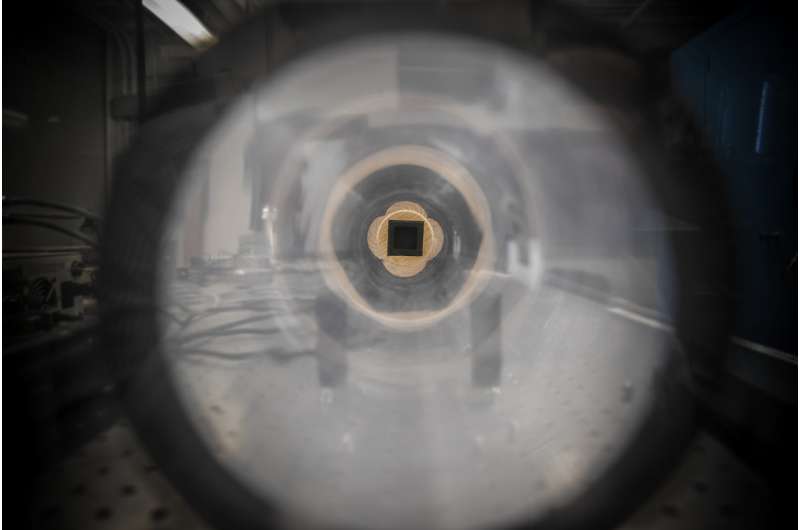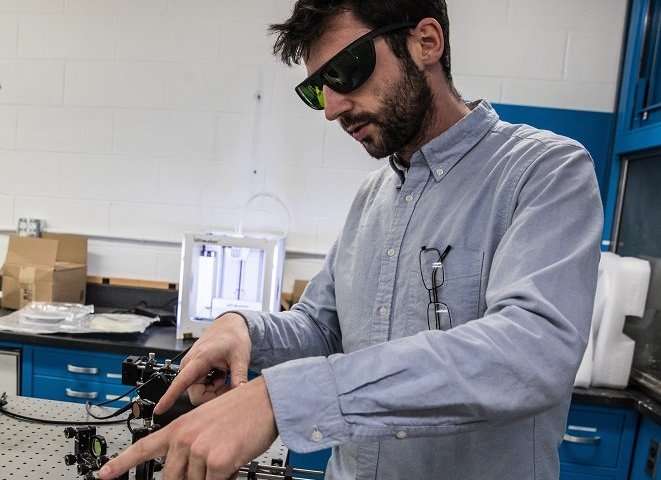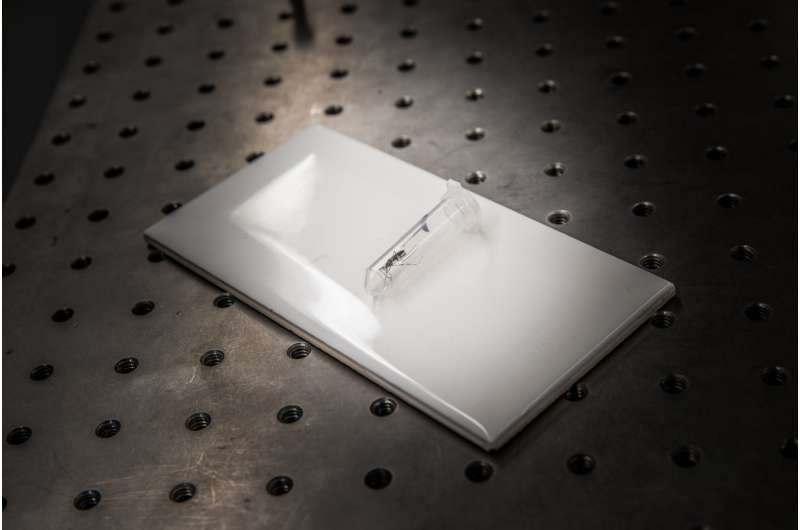Researchers shine new light on disease-spreading mosquitoes

When the West Nile virus (WNV) was initially isolated in two patients at a Queens, N.Y., hospital in the summer of 1999, it would have been hard to anticipate how quickly one common species of house mosquito, Culex pipiens, would help begin to spread the virus throughout the western hemisphere.
Bite-by-bite, coast-to-coast, mosquito populations would transmit the virus—originally discovered in the West Nile province of Uganda more than 75 years ago—to human populations in 44 U.S. states in just three years.
With more than 2,500 different species of mosquitoes known on Earth today, many challenges remain for entomologists and disease control experts aiming to monitor evolving mosquito populations and infectious mosquito-borne disease—which affects nearly 700 million people worldwide and results in more than 1 million human deaths each year.
Physicists are now exploring laser-based technology traditionally used for studying conditions in the atmosphere—such as Light Detection and Ranging (LIDAR)—to shine a light on the subtlest of features of mosquito activity and better track populations that may carry a viral threat.
An investigation led by Benjamin Thomas, assistant professor of physics at NJIT, has adopted the use of LIDAR, an infrared optical remote-sensing technology capable of capturing the rate that mosquitoes beat their wings in flight, known as wing beat frequency (WBF).
By understanding variations of WBF in mosquitoes, Thomas's lab is learning two key characteristics that can help distinguish which mosquitoes may be vectors for infectious disease, from those that are not: species and gender.

"Mosquitoes remain the deadliest animal on Earth by far," said Thomas. "Unfortunately, our current methods for tracking and gathering data about them typically cost a great deal in terms of time and resources, so we have lacked a lot of entomological data about many species and their female populations, which are typically transmitters of diseases."
Current strategies—like pheromone-based physical traps—have been used to accurately study mosquito populations on a small scale. However, Thomas says his team's work could help fill the gap of entomological data at the large scale, giving researchers a better way of surveying the broader evolution of insect populations and their ecosystems, as well as track the spread of mosquito-borne disease."
"In cases like the Zika outbreak, we were mostly following its spread by following reports of illness, always leaving us one step behind the mosquitoes transmitting the virus," said Thomas. "We have been developing a new optical instrument capable of scanning the environment and measuring hundreds of insects per hour in real time. This could give us a better method of gathering large-scale entomological data while helping us track specific species that we know are dangerous in response to an outbreak."
Recording the Beat of Mosquitoes
Although both male and female mosquitoes feature mouth-like anatomy, only female mosquitoes possess mandibles capable of piercing the skin of mammals to suck blood—an adaptation that serves to provide the necessary nutrients for reproduction. Because female mosquitoes exclusively extract blood from humans in this way, identifying them among larger populations is one important step toward tracking potential transmitters of disease.
Thomas's laser-based approach can accurately identify female mosquito WBFs, which typically average around 500 wing beats per second, from the WBFs of their male counterparts, which are normally 600 wing beats per second on average.

"In our lab, the mosquitoes are placed in a tube enclosure and will transit through our instrument's laser path, and based on their wing movement, they'll produce a specific signature of light that reflects back toward the instrument," explained Thomas. "That backscattering of light holds the information that we need to identify whatever crosses the beam ... whether it is a bee, a housefly, a male mosquito or female mosquito. Alongside our laser, we have a telescope that collects all this light and we can analyze that data in real time."
In controlled experiments in the lab, Thomas's team tested its system's ability to accurately distinguish between male and female mosquitoes of four different species that have previously been identified as vectors of disease: Aedes albopictus, Aedes Vexans, Aedes aegypti and another species of the Culex genus.
In the tests, the instrument proved able to identify mosquito gender with 96.5 percent accuracy. However, a trickier prospect for Thomas's lab has been identifying insect species; currently, the lab can identify mosquito species with 75 percent accuracy. In a recent study, published in Conference Proceedings of SPIE, Thomas's team began exploring new optical parameters for better characterizing insect shape and color, which could improve overall species identification.
"Our laser system now incorporates two different infrared wavelengths within the same optical path, so depending on if a species is brown, black or striped, it will affect the strength of the signal coming back from one of the two channels differently," said Thomas. "We have also begun measuring how the light is polarized to better understand surface and shape of insects. For instance, just by measuring the polarization of light coming back to us, we can now tell whether the mosquitoes are carrying eggs or not."
Thomas's lab is now in the process of optimizing its approach for field use—working not only to further improve accuracy of species identification, but also to improve the range of its system's telescope. The team is expanding its telescope's range for collecting light from its current 100-meter range to a few hundred meters in order to collect data from outdoor environments where larger mosquito populations dwell. With safety tests and refinements to the design ongoing, Thomas says field tests could begin as soon as 2019.
"Once our instrument is deployed in the field, we could ideally collect data through an internet connection over the course of a few days," said Thomas. "This could provide us with a huge amount of information about mosquitoes and other insects in the environment. In the long term, future studies could even tell us about how a given population's spatial distribution is evolving as a result of climate change."
More information: Benjamin P. Thomas et al, Analysis of predictor variables for mosquito species identification from dual-wavelength polarization-sensitive lidar measurements, Lidar Remote Sensing for Environmental Monitoring XVI (2018). DOI: 10.1117/12.2323432
Provided by New Jersey Institute of Technology





















